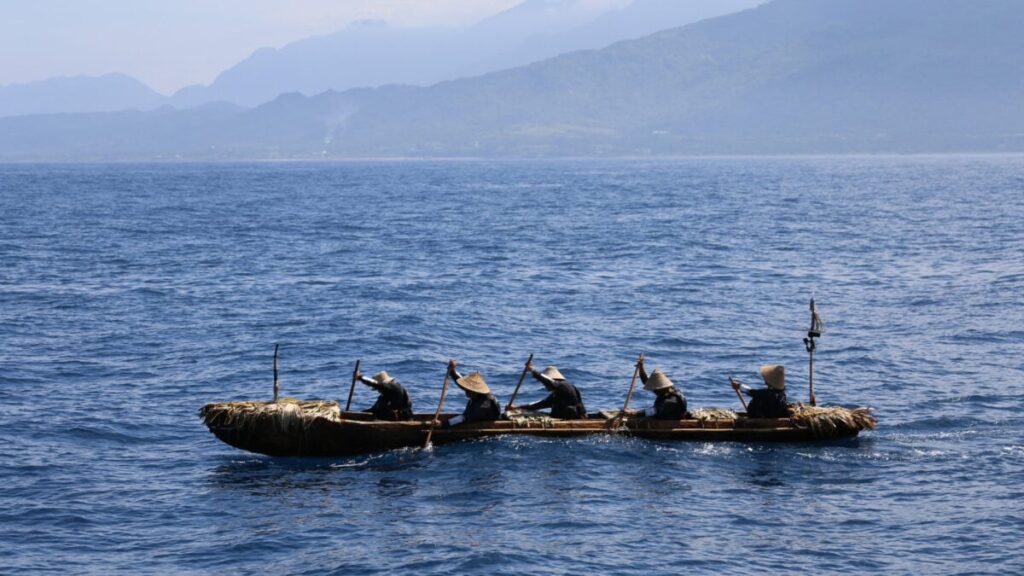
Archaeologists have long debated how humans first arrived on the Ryukyu Islands, located off the southwestern coast of Japan, between 35,000 and 27,500 years ago. The mystery deepens considering they would have had to navigate one of the world’s most formidable ocean currents. To explore this ancient enigma, a team of scientists embarked on a daring experiment to recreate the Paleolithic journey.
Utilizing replicas of tools from the Upper Paleolithic era, researchers in Japan constructed a dugout canoe and successfully traversed the 68.4-mile-wide strait between Taiwan and Yonaguni Island. This journey, which included navigating the powerful Kuroshio current, took approximately 45 hours. The expedition offers a plausible method by which ancient travelers from present-day Taiwan could have reached the islands thousands of years ago.
Reconstructing Ancient Journeys
The researchers’ 7.5-meter-long dugout canoe, crafted with edge-ground stone axes, proved both swift and sturdy enough to complete the crossing. As detailed in their study published in Science Advances, the success of this voyage underscores the early development of functional boats like dugouts. However, the experiment also highlighted the necessity of experienced paddlers with advanced navigational skills.
One significant challenge in studying prehistoric seafaring is the absence of surviving ancient watercraft, as organic materials like wood have long since decayed. In the absence of direct archaeological evidence, experimental archaeology provides a valuable method for exploring ancient practices by recreating them in a controlled historical context.
Experimental Archaeology: A Journey Through Time
Since 2013, University of Tokyo anthropologist Yousuke Kaifu and his colleagues have been attempting to reach the Ryukyu Islands using Paleolithic methods, eschewing modern navigation tools like GPS and compasses. Prior experiments with reed-bundle and bamboo rafts failed to conquer the Kuroshio Current. The successful design emerged as a canoe fashioned from a hollowed and fire-charred Japanese cedar tree, accommodating five crew members.
“Given the absence of archaeological remains of Pleistocene watercraft, we narrowed down the possible Paleolithic seagoing craft by referencing the Holocene archaeological and ethnographic records and considering the material availability, technological limitations of the time, and the voyaging capabilities of each craft,” the researchers explained.
The Holocene epoch, beginning approximately 11,700 years ago, provides a framework for understanding the technological and cultural context of these ancient voyages. By examining these records, the researchers aimed to investigate the travel time, effort required, and other realities of Paleolithic ocean crossings for the first South Ryukyu islanders.
Simulating the Past with Modern Technology
In addition to physical experiments, the team developed computer models to simulate the crossing under Late Pleistocene oceanic conditions. These simulations, which incorporated data from the experimental voyage, suggested that the success of such prehistoric journeys depended on factors like the starting point, directional strategy, and navigational skills using celestial bodies.
“Our separate numerical simulation study suggests that this type of boat could also travel to Yonaguni Island from a different northern departure point in Taiwan (Taroko) across both the modern and Late Pleistocene oceans,” the researchers added.
The study challenges the perception of Paleolithic people as “inferior” due to their “primitive” culture and technology. Instead, it highlights their extraordinary achievements with the rudimentary tools available at the time.
Implications for Understanding Human History
While experimental projects like this cannot replace direct archaeological evidence, they offer creative insights into ancient human ingenuity. This study joins a growing body of hands-on research that provides compelling theories in the absence of material evidence, enriching our understanding of human history.
As researchers continue to explore these ancient journeys, the findings not only illuminate the past but also inspire a deeper appreciation for the resourcefulness of early human societies. The success of this experiment opens new avenues for understanding how our ancestors navigated and settled across vast and challenging landscapes.







